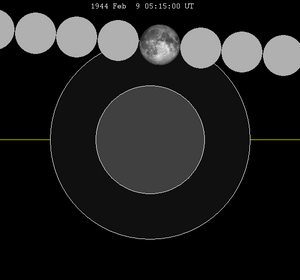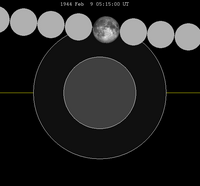| Penumbral eclipse | |||||||||
 The Moon's hourly motion shown right to left The Moon's hourly motion shown right to left | |||||||||
| Date | February 9, 1944 | ||||||||
|---|---|---|---|---|---|---|---|---|---|
| Gamma | 1.2698 | ||||||||
| Magnitude | −0.5223 | ||||||||
| Saros cycle | 142 (14 of 74) | ||||||||
| Penumbral | 226 minutes, 39 seconds | ||||||||
| |||||||||
| ← August 1943July 1944 → | |||||||||
A penumbral lunar eclipse occurred at the Moon's ascending node of orbit on Wednesday, February 9, 1944, with an umbral magnitude of −0.5223. A lunar eclipse occurs when the Moon moves into the Earth's shadow, causing the Moon to be darkened. A penumbral lunar eclipse occurs when part or all of the Moon's near side passes into the Earth's penumbra. Unlike a solar eclipse, which can only be viewed from a relatively small area of the world, a lunar eclipse may be viewed from anywhere on the night side of Earth. Occurring about 1.1 days before apogee (on February 10, 1944, at 7:45 UTC), the Moon's apparent diameter was smaller.
This eclipse was the first of four penumbral lunar eclipses in 1944, with the others occurring on July 6, August 4, and December 29.
Visibility
The eclipse was completely visible over North and South America, west Africa, and western Europe, seen rising over northeast Asia and the central Pacific Ocean and setting over Africa, Europe, and the Middle East.
 
|
Eclipse details
Shown below is a table displaying details about this particular solar eclipse. It describes various parameters pertaining to this eclipse.
| Parameter | Value |
|---|---|
| Penumbral Magnitude | 0.57926 |
| Umbral Magnitude | −0.52225 |
| Gamma | 1.26983 |
| Sun Right Ascension | 21h27m03.0s |
| Sun Declination | -15°01'28.5" |
| Sun Semi-Diameter | 16'12.7" |
| Sun Equatorial Horizontal Parallax | 08.9" |
| Moon Right Ascension | 09h28m05.2s |
| Moon Declination | +16°08'24.5" |
| Moon Semi-Diameter | 14'43.1" |
| Moon Equatorial Horizontal Parallax | 0°54'00.8" |
| ΔT | 26.4 s |
Eclipse season
See also: Eclipse cycleThis eclipse is part of an eclipse season, a period, roughly every six months, when eclipses occur. Only two (or occasionally three) eclipse seasons occur each year, and each season lasts about 35 days and repeats just short of six months (173 days) later; thus two full eclipse seasons always occur each year. Either two or three eclipses happen each eclipse season. In the sequence below, each eclipse is separated by a fortnight.
| January 25 Descending node (new moon) |
February 9 Ascending node (full moon) |
|---|---|
 |

|
| Total solar eclipse Solar Saros 130 |
Penumbral lunar eclipse Lunar Saros 142 |
Related eclipses
Eclipses in 1944
- A total solar eclipse on January 25.
- A penumbral lunar eclipse on February 9.
- A penumbral lunar eclipse on July 6.
- An annular solar eclipse on July 20.
- A penumbral lunar eclipse on August 4.
- A penumbral lunar eclipse on December 29.
Metonic
- Preceded by: Lunar eclipse of April 22, 1940
- Followed by: Lunar eclipse of November 28, 1947
Tzolkinex
- Preceded by: Lunar eclipse of December 28, 1936
- Followed by: Lunar eclipse of March 23, 1951
Half-Saros
- Preceded by: Solar eclipse of February 3, 1935
- Followed by: Solar eclipse of February 14, 1953
Tritos
- Preceded by: Lunar eclipse of March 12, 1933
- Followed by: Lunar eclipse of January 8, 1955
Lunar Saros 142
- Preceded by: Lunar eclipse of January 28, 1926
- Followed by: Lunar eclipse of February 19, 1962
Inex
- Preceded by: Lunar eclipse of March 1, 1915
- Followed by: Lunar eclipse of January 18, 1973
Triad
- Preceded by: Lunar eclipse of April 9, 1857
- Followed by: Lunar eclipse of December 9, 2030
Lunar eclipses of 1940–1944
This eclipse is a member of a semester series. An eclipse in a semester series of lunar eclipses repeats approximately every 177 days and 4 hours (a semester) at alternating nodes of the Moon's orbit.
The penumbral lunar eclipses on April 22, 1940 and October 16, 1940 occur in the previous lunar year eclipse set, and the penumbral lunar eclipses on July 6, 1944 and December 29, 1944 occur in the next lunar year eclipse set.
| Lunar eclipse series sets from 1940 to 1944 | ||||||||
|---|---|---|---|---|---|---|---|---|
| Ascending node | Descending node | |||||||
| Saros | Date Viewing |
Type Chart |
Gamma | Saros | Date Viewing |
Type Chart |
Gamma | |
| 102 | 1940 Mar 23
|
Penumbral
|
−1.5034 | 107 | ||||
| 112 | 1941 Mar 13
|
Partial
|
−0.8437 | 117 | 1941 Sep 05
|
Partial
|
0.9747 | |
| 122 | 1942 Mar 03
|
Total
|
−0.1545 | 127 | 1942 Aug 26
|
Total
|
0.1818 | |
| 132 | 1943 Feb 20
|
Partial
|
0.5752 | 137 | 1943 Aug 15
|
Partial
|
−0.5534 | |
| 142 | 1944 Feb 09
|
Penumbral
|
1.2698 | 147 | 1944 Aug 04
|
Penumbral
|
−1.2843 | |
Saros 142
This eclipse is a part of Saros series 142, repeating every 18 years, 11 days, and containing 73 events. The series started with a penumbral lunar eclipse on September 19, 1709. It contains partial eclipses from May 5, 2088 through July 10, 2196; total eclipses from July 22, 2214 through April 21, 2665; and a second set of partial eclipses from May 3, 2683 through July 29, 2827. The series ends at member 73 as a penumbral eclipse on November 17, 3007.
The longest duration of totality will be produced by member 34 at 103 minutes, 54 seconds on September 15, 2304. All eclipses in this series occur at the Moon’s ascending node of orbit.
| Greatest | First | |||
|---|---|---|---|---|
| The greatest eclipse of the series will occur on 2304 Sep 15, lasting 103 minutes, 54 seconds. | Penumbral | Partial | Total | Central |
| 1709 Sep 19 |
2088 May 05 |
2214 Jul 22 |
2250 Aug 13 | |
| Last | ||||
| Central | Total | Partial | Penumbral | |
| 2448 Dec 10 |
2665 Apr 21 |
2827 Jul 29 |
3007 Nov 17 | |
Eclipses are tabulated in three columns; every third eclipse in the same column is one exeligmos apart, so they all cast shadows over approximately the same parts of the Earth.
| Series members 7–28 occur between 1801 and 2200: | |||||
|---|---|---|---|---|---|
| 7 | 8 | 9 | |||
| 1817 Nov 23 | 1835 Dec 05 | 1853 Dec 15 | |||
| 10 | 11 | 12 | |||
| 1871 Dec 26 | 1890 Jan 06 | 1908 Jan 18 | |||

|

| ||||
| 13 | 14 | 15 | |||
| 1926 Jan 28 | 1944 Feb 09 | 1962 Feb 19 | |||

|

|

|

|

|

|
| 16 | 17 | 18 | |||
| 1980 Mar 01 | 1998 Mar 13 | 2016 Mar 23 | |||

|

|

|

|

|

|
| 19 | 20 | 21 | |||
| 2034 Apr 03 | 2052 Apr 14 | 2070 Apr 25 | |||

|

|

|

|

|

|
| 22 | 23 | 24 | |||
| 2088 May 05 | 2106 May 17 | 2124 May 28 | |||
| 25 | 26 | 27 | |||
| 2142 Jun 08 | 2160 Jun 18 | 2178 Jun 30 | |||
| 28 | |||||
| 2196 Jul 10 | |||||
Half-Saros cycle
A lunar eclipse will be preceded and followed by solar eclipses by 9 years and 5.5 days (a half saros). This lunar eclipse is related to two total solar eclipses of Solar Saros 149.
| February 3, 1935 | February 14, 1953 |
|---|---|

|

|
See also
References
- "February 8–9, 1944 Penumbral Lunar Eclipse". timeanddate. Retrieved 19 December 2024.
- "Moon Distances for London, United Kingdom, England". timeanddate. Retrieved 19 December 2024.
- "Penumbral Lunar Eclipse of 1944 Feb 09" (PDF). NASA. Retrieved 19 December 2024.
- "Penumbral Lunar Eclipse of 1944 Feb 09". EclipseWise.com. Retrieved 19 December 2024.
- van Gent, R.H. "Solar- and Lunar-Eclipse Predictions from Antiquity to the Present". A Catalogue of Eclipse Cycles. Utrecht University. Retrieved 6 October 2018.
- "NASA - Catalog of Lunar Eclipses of Saros 142". eclipse.gsfc.nasa.gov.
- Listing of Eclipses of series 142
- Mathematical Astronomy Morsels, Jean Meeus, p.110, Chapter 18, The half-saros
External links
- Saros series 142
- 1944 Feb 09 chart Eclipse Predictions by Fred Espenak, NASA/GSFC
This lunar eclipse-related article is a stub. You can help Misplaced Pages by expanding it. |


